After a powerful storm, one of the most vulnerable parts of your home is the roof. Strong winds, heavy rain, and debris can all cause damage that isn’t always visible from the ground. Ignoring small issues after a storm can quickly lead to leaks, structural problems, and costly repairs later on.
At Stapleford Roofing Repairs, we regularly assist homeowners across Stapleford and Nottingham following severe weather, helping them identify and fix roof damage before it escalates. Below are six essential post-storm inspection tips every homeowner should follow to keep their roof safe and sound.
Why Post-Storm Inspections Are Essential
A roof inspection after bad weather is not just a precaution — it’s a key step in protecting your property. Even if your roof looks fine at first glance, minor damage can worsen over time, allowing water to penetrate beneath tiles or flashing. Early detection helps prevent more serious issues such as structural weakening or internal dampness.
1. Check for Missing or Damaged Tiles
The first and most obvious sign of storm damage is missing, cracked, or displaced roof tiles. High winds can lift tiles from their fixings, leaving exposed patches that compromise the roof’s waterproofing.
What to Look For:
- Gaps or uneven areas in the roof line.
- Cracked or slipped tiles visible from the ground.
- Pieces of broken tile found in the garden or driveway.
If you notice any of these signs, it’s important to have them repaired promptly. Stapleford Roofing Repairs can safely assess the damage and replace affected tiles to restore your roof’s integrity.
2. Inspect Flashing and Roof Edges
Flashing around chimneys, skylights, and vents plays a crucial role in preventing leaks. Storms often cause this thin metal material to loosen or tear away.
Areas to Examine:
- Chimney bases and brick joints.
- Valleys where two roof slopes meet.
- Around dormer windows and roof penetrations.
Loose flashing can lead to leaks that may not be immediately visible, but over time, moisture can seep into the loft and insulation. A professional inspection from Stapleford Roofing Repairs ensures these vulnerable areas are checked and resealed where necessary.
3. Examine Gutters and Downpipes
Your guttering system helps channel rainwater away from your property, but storms can easily clog or damage it. Blockages or broken sections can cause overflow, leading to damp patches on walls or fascia boards.
Post-Storm Gutter Checks:
- Remove leaves, twigs, and debris that have accumulated.
- Check that downpipes are securely attached and draining freely.
- Look for any sagging or cracked gutter sections.
Keeping your gutters clear after a storm prevents unnecessary strain on the roofline and reduces the risk of water pooling.
4. Inspect the Loft or Roof Space
One of the most effective ways to identify hidden damage is by checking inside your roof space. After a storm, signs of water ingress or daylight peeking through are clear warnings that repairs are needed.
Inside the Loft, Look For:
- Damp insulation or water staining on rafters.
- Drips or condensation forming during rainfall.
- Small patches of mould or mildew growth.
Early detection in these areas can save significant time and cost in the future. Stapleford Roofing Repairs often finds that leaks discovered early can be fixed quickly before major issues develop.
5. Look for Fallen Branches or Debris
Branches, leaves, and other debris are common after a storm and can cause damage even if they don’t appear to have punctured the roof. A heavy branch scraping tiles can loosen fixings or create cracks that may worsen over time.
Steps to Take:
- Safely clear any lightweight debris that’s accessible.
- Avoid climbing onto the roof — it’s best to have professionals inspect for hidden cracks.
- Trim nearby trees to reduce future risks of falling branches.
Our team at Stapleford Roofing Repairs can safely remove large debris and assess whether your roof’s structure or tiles have been compromised.
6. Assess the Soffits, Fascia, and Eaves
The edges of your roofline — including soffits and fascia boards — are often overlooked during inspections, but they’re vital for ventilation and protecting your home from moisture.
What to Watch Out For:
- Peeling paint or visible damp spots.
- Warped boards or visible gaps where water could enter.
- Signs of pest activity, such as small holes or nests.
Strong winds and heavy rain can loosen fixings or push water behind these areas. Professional repair ensures your roofline remains weather-resistant and durable.
When to Call a Professional Roofing Contractor
While a basic visual inspection is useful, not all damage is visible from ground level. Some problems — such as cracked flashing or lifted underlay — require a trained eye and specialist equipment.
By contacting a local expert such as Stapleford Roofing Repairs, you ensure a safe and thorough assessment of your roof. Our team provides professional inspections and lasting repair solutions for homeowners throughout Stapleford and Nottingham, restoring roofs to full strength after storms.
Conclusion
Storms can strike without warning, and even minor damage can lead to long-term problems if left unaddressed. By following these six inspection tips — checking tiles, flashing, gutters, loft spaces, debris, and roofline components — homeowners can protect their property from further deterioration.
Stapleford Roofing Repairs in Stapleford, Nottingham, offers reliable post-storm roof inspections and repairs to help keep your home secure and weatherproof. Prompt action and expert maintenance ensure your roof continues to perform its essential role — protecting your home from the elements year after year.
Call us on: 0115 647 1193
Click here to find out more about Stapleford Roofing Repairs
Click here to complete our contact form and see how we can help with your roofing needs.

